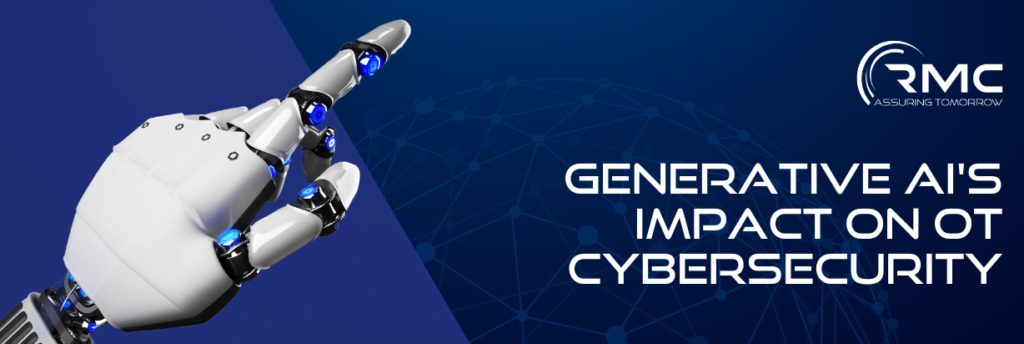By Vince Kuchar
CEO, RMC Global
The advent of generative AI technologies, most notably ChatGPT, has brought about both excitement and apprehension within the Operational Technology (OT) cybersecurity community. Among the latest advancements in this domain is PentestGPT, a specialized tool adept at conducting automated penetration tests, a cornerstone in pinpointing security vulnerabilities.
Drawing from the expert insights of our OT security team at RMC Global, we aim to unravel the diverse applications and implications of generative AI for OT cybersecurity. As we forge ahead, it’s evident that these unconventional tools not only augment our strategies for crafting resilient industrial control systems but also usher in a new era replete with challenges for cyber defenders. Dive in with us as we navigate the nuances of this transformative technology.
Leveraging AI in Defense and Offense
Defensive Strategies – AI can greatly enhance an organization’s defenses by detecting and/or preventing cyberattacks with faster response times. By analyzing large quantities of data and discerning patterns more quickly, AI enables a highly targeted approach to defense. It can even predict maintenance needs, which could avoid unexpected production downtime. Such capabilities can help reduce the workload of incident response and Security Operations Center (SOC) teams, shifting from broadly scoped and often inefficient techniques to a targeted and anticipatory approach. This dynamic shift could spark a new era of precision in OT cybersecurity.
Offensive Strategies – Conversely, AI tools like PentestGPT can be harnessed for offensive purposes by unskilled “script kiddies” unversed in the intricacies of control systems who seek to exploit systems and wreak havoc. This brings up concerning questions for OT devices, which are often insecure by design and implemented in default configurations. Generative AI models can identify known vulnerabilities in various vendor products, vectoring attacks toward weak links, increasing the probability of success. There is a well-known example in a Zero Day Initiative hackathon, as reported by the Wall Street Journal, in which researchers used ChatGPT to find several weaknesses in industrial systems. This sophistication in attack methods demands immediate and equally innovative countermeasures.
Human Element in Automation
AI’s worth in detection, automation, and threat prediction is unquestioned. It adds depth and insight into the fabric of cybersecurity, but it cannot fully capture or understand the complexity of the human element.
While AI operates based on algorithms, patterns, and vast data processing capabilities, there remains an intrinsic value in human intuition and judgment. This becomes particularly evident when faced with novel threats or situations in which historical data is not an accurate predictor of future vulnerabilities.
The significance of human expertise in OT systems and cybersecurity should not be overlooked. Even as technology has evolved, the discerning human eye, built upon years of experience, has played a pivotal role in navigating gray areas and confronting unforeseen challenges.
One such testament to the indispensable nature of human intervention is the incident with Qantas Flight 72. When faced with unforeseen glitches in control systems, it was human decision-making that thwarted an airline disaster and saved countless lives. Such incidents serve as stark reminders that while AI can process information at unparalleled speeds, it cannot replicate the emotional intelligence, moral compass, and adaptability of a human being.
The balance between machine efficiency and human insight is delicate. As we integrate AI further into our cybersecurity strategies, we must ensure that we don’t compromise the irreplaceable value of human judgment. The future of OT cybersecurity hinges on a harmonious blend of AI’s computational prowess and the unique insights that only humans can bring to the table.
AI-powered OT Attacks & Disruptions: A New Landscape
Generative AI is quickly reshaping the field of cybersecurity. With its ability to craft exploits in seconds, simulate attacks that mirror real human behaviors, and automate intricate processes, it is both an asset and a risk. While it opens new avenues for innovation and resilience, it concurrently propels threats that are highly sophisticated and, at times, indistinguishable from legitimate activities.
In the realm of OT, the implications are even more pronounced. Cyberattacks in OT aren’t just about data breaches and encrypted hard drives; they can translate to real-world impact. OT systems help operate airplanes and manage chemical plants. A well-crafted AI-driven cyber assault on these systems could lead to catastrophic outcomes, from equipment failure to potential loss of life.
This rapid AI progression raises critical questions for our industry. Are our traditional defense mechanisms agile enough to combat these next-gen threats? Are we, as an industry, truly prepared for AI’s magnitude in such cyber-physical environments? The essence of these challenges isn’t purely technological. Addressing them demands a blend of innovative defenses, strategic foresight, and, above all, steadfast human oversight.
Concluding Thoughts
The integration of AI into OT cybersecurity is complex, filled with novel opportunities and vulnerabilities. It demands innovation in both defensive and offensive strategies and a reevaluation of traditional approaches.
At RMC Global, our exploration of AI’s applications in OT security is guided by an unwavering commitment to innovation, realism, and the irreplaceable human factor. The journey through this new frontier will continue to unveil challenges and triumphs. By maintaining an approach that respects technological innovation and human intuition, we are prepared to navigate the domain of OT cybersecurity. The double-edged sword of innovation may cut both ways, but with wisdom and vigilance, it can shape a more secure and promising future.
Be sure to follow RMC Global on LinkedIn, and bookmark our News & Perspectives website to stay apprised of industry insights and topical advice on establishing cyber resiliency in OT environments.

